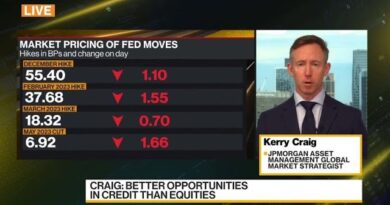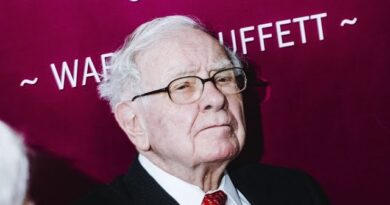
The S&P 500 Just Did Something It Has Only Done Once in History, and It Could Signal a Big Move in the Stock Market

The S&P 500 outperformed its equal-weight counterpart by more than 10% in the first half of 2024, something that has only happened once before.
The S&P 500 (^GSPC -0.41%) outperformed the S&P 500 Equal Weight Index by more than 10% during the first half of the year, something that has happened just once before. A handful of artificial intelligence (AI) companies were responsible. The companies in question have become so big that they influence the index’s performance to a significant degree.
Specifically, Nvidia alone has contributed 30% of the gains in the S&P 500 year to date. In addition, Microsoft, Amazon, and Alphabet have collectively contributed 26% of the gains, and Apple and Meta Platforms have collectively contributed 11% of the gains. In short, six companies drove two-thirds of the upside in the S&P 500 through June.
Some analysts have described that phenomenon as a stock market bubble, and they have expressed concern that the growing clout of a few AI companies could lead to a dot-com-style crash. But history says the increasing concentration of the S&P 500 could be a good thing.
In the past, when the S&P 500 has outperformed its equal-weight counterpart during the first half of the year, the index has typically generated exceptional returns during the next 12 months. Here’s what investors should know.
History says the S&P 500 could return 18% by June 2025
The S&P 500 tracks 500 large U.S. companies. The index is weighted by market capitalization, meaning larger companies impact its performance to a greater degree. The S&P 500 Equal Weight Index (EWI) tracks the same 500 companies, but its equally weighted components impact performance to the same degree. The S&P 500 EWI was created in 2003, but back-tested values begin in 1971.
Since then, the S&P 500 has outperformed its equal-weight counterpart during the first half of the year 16 times. Even more rare, the S&P 500 has outperformed by more than 10% two times. That happened most recently in the first half of 2024, when the S&P 500 returned 14.5% and the S&P 500 EWI returned 4.1%. But that incident is hardly comparable to the previous one in 1973.
To elaborate, the S&P 500 and the S&P 500 EWI declined sharply in the first half of 1973. The S&P 500 merely declined less sharply, such that it outperformed by 10.7%. That differs from the current situation because both indexes have moved higher in 2024. So investors shouldn’t compare those two events in isolation.
Instead, it makes more sense to examine every year in which the S&P 500 beat the S&P 500 EWI during the first half. The chart below accomplishes that. It shows the extent of the S&P 500’s outperformance in the first half, and it shows the S&P 500’s return over the next 12 months.
|
Year |
S&P 500 First-Half Outperformance |
S&P 500 12-Month Return |
|---|---|---|
|
1972 |
2.7% |
(2.7%) |
|
1973 |
10.7% |
(17.5%) |
|
1984 |
2.1% |
25.4% |
|
1990 |
2.5% |
3.7% |
|
1995 |
1.2% |
23.1% |
|
1996 |
0.5% |
32% |
|
1997 |
4% |
28.1% |
|
1998 |
6.2% |
21.1% |
|
2000 |
0.5% |
(15.8%) |
|
2012 |
1.3% |
17.9% |
|
2015 |
0.5% |
1.7% |
|
2017 |
1.2% |
12.2% |
|
2018 |
0.9% |
8.2% |
|
2020 |
7.7% |
38.6% |
|
2023 |
9.9% |
22.7% |
|
Median |
17.9% |
Data source: YCharts.
As shown, when the S&P 500 has outperformed its equal-weight counterpart during the first half of a year, it returned a median of 17.9% during the next 12 months. Past performance is never a guarantee of future results, but history implies significant upside in the S&P 500 — nearly 18% — through June 2025.
Artificial intelligence stocks are not in a dot-com-like bubble
Some analysts have described the recent surge in artificial intelligence stocks, especially chipmaker Nvidia, as a “stock market bubble.” Some have even compared the current market environment to the dot-com bubble, an event that ultimately cut the technology sector to ribbons.
Neil Shearing at Capital Economics recently said, “Enthusiasm around AI has all the hallmarks of an inflating bubble.” Colleagues Diana Iovanel and James Reilly added: “We suspect the bubble will ultimately burst beyond the end of next year, causing a correction in valuations. After all, this dynamic played out around both the dot-com bubble of the late 1990s and early 2000s and the Great Crash of 1929.”
Investors should avoid thinking along those lines. The current environment — that is to say, the AI euphoria that has arisen since the launch of ChatGPT — bears only a superficial resemblance to the dot-com bubble. There are two important distinctions.
First, the technology-heavy Nasdaq-100 surged 270% during the 18 months leading up to March 2000. At that point, the index reversed course and plunged 80% in about two years. That differs dramatically from the recent AI-fueled rally. The Nasdaq-100 has advanced just 80% over the past 18 months.
Second, the seven largest Nasdaq-100 stocks traded at an average valuation of 80 times earnings in March 2000, according to Capital Group. Again, that differs dramatically from the current situation. The seven largest Nasdaq-100 stocks currently trade at an average valuation of 46 times earnings.
I am not saying every AI stock is fairly valued, nor am I saying the excitement surrounding AI will drive the stock market higher indefinitely. Technology often follows the Gartner Hype Cycle, which stipulates that (1) irrational excitement first pushes stocks too high, (2) irrational pessimism then drags stocks too low, and (3) reasonable expectations final set stocks on a gradual upward trajectory.
Here’s the bottom line: History says the S&P 500 will advance 18% over the next year, but there is no guarantee that will happen. Wall Street could become disenchanted with AI stocks tomorrow and the S&P 500 could decline sharply if other concerns, such as valuations or the economy, steal focus.
However, no matter which way the winds blow in the coming months, I don’t believe the current market environment is similar to the dot-com bubble. And AI is not an overhyped phenomenon destined to disappoint. Instead, it will create tremendous wealth for patient investors. To quote UBS analysts, “AI will be the most profound innovation and one of the largest investment opportunities in human history.”
Suzanne Frey, an executive at Alphabet, is a member of The Motley Fool’s board of directors. John Mackey, former CEO of Whole Foods Market, an Amazon subsidiary, is a member of The Motley Fool’s board of directors. Randi Zuckerberg, a former director of market development and spokeswoman for Facebook and sister to Meta Platforms CEO Mark Zuckerberg, is a member of The Motley Fool’s board of directors. Trevor Jennewine has positions in Amazon and Nvidia. The Motley Fool has positions in and recommends Alphabet, Amazon, Apple, Meta Platforms, Microsoft, and Nvidia. The Motley Fool recommends Gartner and recommends the following options: long January 2026 $395 calls on Microsoft and short January 2026 $405 calls on Microsoft. The Motley Fool has a disclosure policy.



